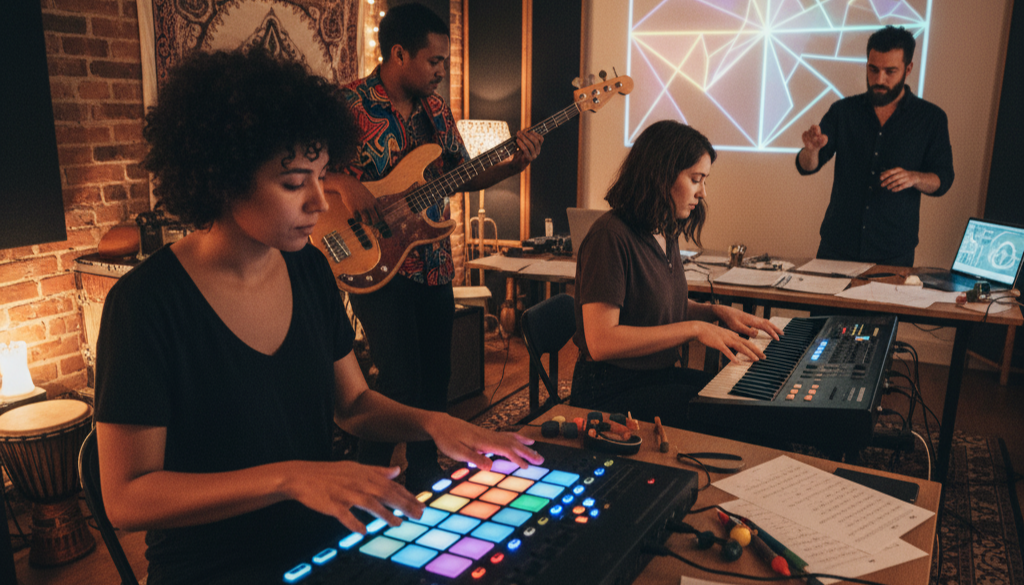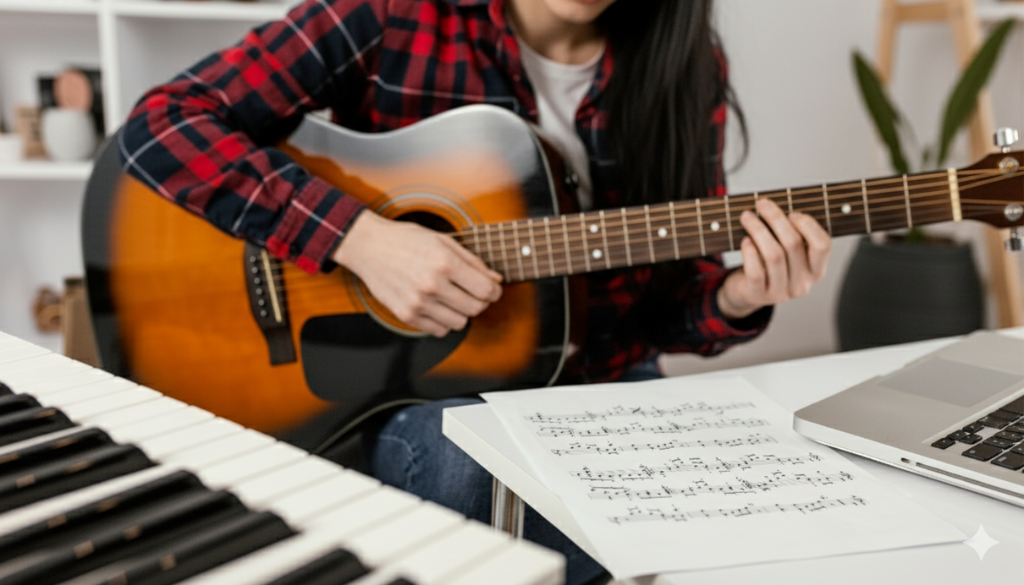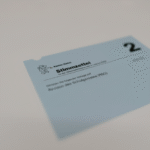Every great piece of music or poetry flows with a sense of timing and pulse that captivates its audience. This pulse, known as rhythm, gives structure and emotion to sound and language alike. A rhythmic pattern forms the backbone of rhythm—it’s the repeated arrangement of beats, stresses, or syllables that makes a line of verse dance or a melody unforgettable. Whether you’re a songwriter, a poet, or simply someone fascinated by the art of timing, understanding rhythm patterns can deepen your appreciation for both music and poetic rhythm.
In this comprehensive guide, we’ll explore the meaning of rhythm pattern, the elements of rhythm, and how rhythm works across poetry and music. You’ll see examples of rhythmic patterns in famous works, learn to identify different rhythmic structures, and understand how rhythm affects emotional expression. By the end, you’ll be equipped to recognize and even create your own poem rhythm pattern or musical groove that resonates deeply with audiences.
1. Understanding Rhythm: The Heartbeat of Expression
Rhythm is the essential pulse that drives both music and poetry. It organizes sound and silence into patterns that create movement, mood, and meaning. At its core, rhythm isn’t just about sound—it’s about timing and energy flow.
In music, rhythm guides the listener through sequences of beats and pauses. In poetry, it directs how syllables and stresses fall within a line. The rhythmic pattern acts as a roadmap for this motion, giving each piece its unique pace and feeling.
1.1 What Is a Rhythmic Pattern?
A rhythmic pattern is a sequence of sounds and silences, stresses and pauses, that repeat in a structured way. Think of it as the “blueprint” of rhythm—an arrangement that defines the pulse and flow.
In a song, this might be a drumbeat like “ta-ta-ta-tum.” In a poem, it could be the repetition of stressed and unstressed syllables, such as in iambic pentameter.
1.2 The Importance of Rhythm in Art
Without rhythm, music would feel chaotic, and poetry would lose its voice. Rhythm provides:
- Structure: It creates order in sound.
- Emotion: Different rhythmic patterns evoke distinct moods—calm, excitement, sadness, or joy.
- Memory: Repetition helps listeners or readers recall the piece easily.
- Unity: Rhythm ties together words, notes, and phrases into a harmonious whole.
In both Rhythm in Music and rhythmic pattern poems, rhythm is what connects logic to feeling. It’s both science and art—timing meets emotion.
The Snowball Kiss is a playful and romantic winter moment that captures the warmth of love in the cold season. Picture two people outside on a snowy day — cheeks rosy, laughter echoing, and snowflakes gently falling. One forms a soft snowball, teasingly taps it against the other’s cheek, and before the laughter fades, they share a sweet, cozy kiss under the snow. It’s the kind of moment that feels straight out of a holiday movie — spontaneous, innocent, and full of affection. The snowball kiss isn’t just about the playful act; it symbolizes connection, joy, and the simple beauty of finding warmth in each other when the world is cold around you.
2. The Elements of Rhythm
To truly master rhythmic patterns, you must understand the elements of rhythm—the building blocks that form its structure.
2.1 Beat
The beat is the basic unit of time in rhythm. It’s the steady pulse that listeners tap their feet to. Every rhythmic pattern is based on an underlying beat.
2.2 Tempo
Tempo refers to the speed of the beat—how fast or slow the rhythm moves. Measured in beats per minute (BPM), tempo defines a song’s or poem’s pace.
2.3 Meter
Meter organizes beats into repeating groups, such as 3/4 or 4/4 time in music, or patterns of stressed/unstressed syllables in poetry. Meter shapes how rhythm is perceived.
2.4 Accent
An accent emphasizes certain beats or syllables, giving rhythm its dynamic texture. In poetry, it marks stress; in music, it defines groove.
2.5 Duration
Duration is how long each sound lasts. Long and short notes or syllables create contrast and interest within rhythmic flow.
Together, these elements of rhythm combine to form structured, expressive patterns that bring life to artistic creations.
3. Rhythmic Patterns in Music

Music thrives on rhythm. It gives direction to melody and harmony and defines the style of a composition. Different genres rely on specific rhythmic patterns to create their signature sound.
3.1 The Role of Rhythm in Music
In Rhythm in Music, This drives both the emotional and physical experience. When listeners dance or nod along, they’re responding to rhythm. Whether it’s the swing of jazz, the groove of funk, or the march of classical pieces, rhythm dictates movement and mood.
3.2 Common Musical Rhythmic Patterns
Here are several examples of patterns that dominate musical styles:
- 4/4 Beat (Common Time): The most prevalent pattern in modern music. It creates a steady, predictable flow perfect for pop, rock, and dance.
- 3/4 Waltz Time: Used in classical and folk music, giving a lilting, circular motion.
- 2/4 March Rhythm: Energetic and crisp, suitable for marches and quickstep dances.
- 6/8 Compound Rhythm: Creates a swinging, rolling feel often used in ballads or blues.
Each of these patterns creates distinct emotional impressions. Even within the same tempo, the pattern can transform a song’s personality.
3.3 Syncopation: The Magic of Offbeat Rhythm
One of the most exciting rhythmic techniques in music is syncopation—accenting the offbeats. This unexpected emphasis gives music energy and surprise. Think of jazz or reggae; their charm lies in this rhythmic twist.
3.4 Polyrhythm and Cross-Rhythm
Advanced musicians often use polyrhythms, where two different rhythmic patterns play simultaneously. For instance, African drumming may layer a 3-beat rhythm over a 4-beat base. This complexity enriches texture and depth.
3.5 Practical Tip: Finding Rhythm in Everyday Sounds
To develop rhythmic awareness, listen to everyday noises—the ticking of a clock, footsteps, rain on a window. These natural sounds follow their own patterns. Recognizing rhythm in daily life strengthens your creative intuition.
4. Rhythmic Patterns in Poetry
Poetry uses rhythm to evoke emotion, emphasize meaning, and create musicality. Every poem has a rhythmic pattern, consciously or subconsciously embedded in its structure.
4.1 The Nature of Poetic Rhythm
In poetry, rhythm emerges from the arrangement of syllables and stresses in each line. Just as music has time signatures, poetry has meter—a repeating pattern of stressed (´) and unstressed (˘) syllables.
4.2 Types of Poetic Meters
Here are some common meters that define poem rhythmic patterns:
- Iambic Meter (˘ ´): Unstressed followed by stressed, as in Shakespeare’s sonnets:
“Shall I compare thee to a summer’s day?” - Trochaic Meter (´ ˘): Stressed followed by unstressed, giving a rhythmic fall.
“Tell me not in mournful numbers.” - Anapestic Meter (˘ ˘ ´): Two unstressed followed by one stressed, creating a galloping rhythm.
“’Twas the night before Christmas.” - Dactylic Meter (´ ˘ ˘): One stressed followed by two unstressed; often used in classical verse.
Each rhythmic poem generates a distinct emotional tone and pace.
4.3 Free Verse and Modern Rhythm
Not all poetry follows a strict metrical pattern. Free verse uses natural speech rhythms to create flow. Poets like Walt Whitman and Langston Hughes built musical rhythm through imagery and phrasing rather than consistent meter. Even without formal patterns, their works pulse with organic rhythm.
4.4 Enjambment and Pause: Tools of Rhythm
Poetic rhythm also depends on how lines break. Enjambment—continuing a sentence beyond a line—creates forward momentum, while a caesura (a pause) invites reflection. Master poets use both to control tempo and emphasis, crafting rhythm not just through meter but through pacing.
5. Connecting Music and Poetry Through Rhythm

Music and poetry are siblings connected by rhythm. Their structures differ, but their essence is shared. Both rely on timing, repetition, and variation to stir emotion.
5.1 Similarities Between Musical and Poetic Rhythms
- Both use patterns of stress or beat to create motion.
- Both depend on repetition to build expectation and release.
- Both can be simple or complex, depending on style and intention.
In a sense, music in the rhythm of poetry gives words melody, while poetic structure gives lyrics depth.
5.2 How Musicians Use Poetic Rhythm
Many lyricists write songs like poems first, ensuring rhythm and rhyme fit naturally before setting them to music. The rhythmic pattern of lyrics must complement the musical beat; otherwise, phrasing feels forced.
5.3 How Poets Borrow from Musical Rhythm
Conversely, modern poets often draw inspiration from jazz, blues, or hip-hop, echoing syncopation and repetition. This cross-pollination keeps rhythm alive as a shared artistic language.
6. Examples of Rhythmic Patterns
To see rhythm in action, here are examples of rhythmic across art forms:
6.1 In Music
- Pop Song: A steady 4/4 beat—predictable, catchy, and easy to follow.
- Classical Piece: Alternating between 3/4 and 4/4, adding dynamic variation.
- Jazz Composition: Syncopated beats and polyrhythms create improvisational flow.
- Hip-Hop Track: Layered beats with strong backbeats on 2 and 4 enhance groove.
6.2 In Poetry
- Iambic Pentameter: Five iambs per line, giving smooth balance.
- Haiku Rhythm: Short, natural syllabic flow (5-7-5 structure).
- Free Verse Example: Variable line lengths but strong internal pacing.
6.3 In Dance and Nature
Rhythm is universal—it exists in heartbeat patterns, walking pace, tides, and seasons. Dancers translate rhythmic patterns into motion; nature reflects them in cycles.
7. How to Create Your Own Rhythmic Pattern
Mastering rhythm involves practice, observation, and experimentation. Here’s how to craft your own pattern:
- Listen Intently: Observe rhythms in everyday life—music, speech, footsteps.
- Start Simple: Begin with steady beats; feel the tempo before complicating it.
- Experiment with Silence: Pauses add as much rhythm as sound.
- Play with Emphasis: Shift accents to change emotional impact.
- Record and Reflect: Play or recite your pattern to check its flow.
Remember, rhythm isn’t about perfection but about balance and feeling.
8. Emotional Power of Rhythm
Why does rhythm move us? Because it mirrors life itself—heartbeat, breath, and movement all follow rhythmic cycles.
Fast rhythms excite us; slow ones calm us. Repetition feels comforting, while variation introduces tension. Artists use these natural reactions to connect emotionally with their audience.
For example, a rhythmic pattern poem with short, staccato lines may convey urgency, while long flowing lines soothe. Similarly, a syncopated beat can make listeners feel surprise and delight.
9. Common Mistakes in Using Rhythm
Even experienced artists can misuse rhythm. Here are common pitfalls to avoid:
- Overcomplicating patterns: Complexity without purpose confuses rather than impresses.
- Ignoring natural flow: Rhythm should enhance meaning, not overpower it.
- Lack of consistency: Sudden shifts break immersion unless intentionally used.
- Monotony: Too much repetition dulls interest—introduce variation to stay engaging.
Balance is the secret: rhythm should serve the art, not dominate it.
10. Practical Exercises for Rhythm Mastery

Try these short activities to strengthen rhythmic awareness:
- Clap the Beat: Choose a song or poem, clap its rhythm, and notice patterns.
- Read Aloud: Emphasize stresses and pauses to feel poetic rhythm.
- Write a Poem to a Beat: Match words to a metronome tempo.
- Improvise Sounds: Tap, hum, or drum to express emotion rhythmically.
- Analyze Favorites: Study how great songs or poems manage flow and timing.
Over time, these exercises refine your instinct for rhythmic beauty.
11. Rhythm Across Cultures
Different cultures express rhythm uniquely. African drumming emphasizes polyrhythm, Indian classical music explores complex cycles called talas, while Western classical relies on meter precision.
In poetry, too, languages shape rhythm: English stresses syllables, Japanese counts them, and Arabic poetry blends both. This diversity shows rhythm’s universality—it’s the shared language of human expression.
12. The Science Behind Rhythm
Scientific studies show rhythm activates brain regions linked to movement and emotion. That’s why we instinctively tap feet or nod to beats. Rhythm synchronizes our bodies with sound, creating a sense of unity and pleasure.
Even in speech, rhythmic cadence influences persuasion and recall. Great orators—from Martin Luther King Jr. to modern performers—use rhythm to captivate attention.
13. The Future of Rhythm in Art
Technology has expanded rhythm’s possibilities. Digital tools let artists design intricate beats, while poets use visual layouts to create rhythmic pacing on screen. AI, loops, and synthesizers push rhythm into new dimensions, yet its essence remains the same: pattern, timing, and emotion.
14. Rhythmic Pattern in Language and Speech
Even outside poetry, rhythm shapes how we communicate. Everyday conversation carries rhythmic nuances—the way we emphasize words, pause for effect, or modulate tone forms a rhythmic pattern of speech. Public speakers, actors, and storytellers all rely on rhythm to keep their audiences engaged. A well-paced pause can create tension; a quick burst of words can spark excitement. Understanding rhythm in language enhances clarity, emotion, and memorability.
15. Teaching Rhythm: From Classrooms to Studios
Educators often use rhythm as a bridge between logic and creativity. In music education, teachers introduce students to rhythm through clapping, tapping, and simple drumming exercises. In literature classes, analyzing poem rhythmic patterns helps students feel the movement of words rather than just reading them. Rhythmic learning strengthens memory and coordination, making it a powerful educational tool for all ages.
16. Emotional Resonance of Different Rhythms
Each rhythmic pattern carries emotional weight. A slow, steady rhythm evokes calmness or melancholy, while rapid beats convey excitement or urgency. In poetry, short rhythmic bursts mirror anxiety or passion; in music, sustained legato rhythms may symbolize peace. Artists manipulate these emotional associations intentionally, using rhythm as an invisible storyteller that guides the audience’s heart and imagination.
17. The Role of Silence in Rhythm
It might seem paradoxical, but silence plays a crucial role in rhythmic design. The pauses between sounds—the rests in music or caesuras in poetry—give rhythm its shape. Without space, sound becomes noise. Silence provides contrast, allowing rhythm to breathe. Mastering the balance between sound and silence is what elevates a rhythmic pattern from mechanical to magical.
18. Rhythmic Patterns in Modern Genres
Contemporary music genres experiment boldly with rhythm. In electronic music, producers layer complex beats and sub-beats to build texture. In hip-hop, rhythm drives both lyrics and flow, turning voice into percussion. Spoken-word poetry borrows from both, blending music in the rhythm of storytelling. Each modern form redefines how rhythm interacts with language, technology, and performance, proving its timeless adaptability.
19. Cultural Interpretation of Rhythm
Across the world, different societies interpret rhythm through unique cultural lenses. African rhythms often focus on communal participation, Indian talas emphasize cyclical time, and Western compositions explore linear progression. Yet, all share a sense of pulse and repetition—a universal heartbeat. This cultural diversity demonstrates that while patterns differ, the human instinct for rhythm is universal.
20. The Psychology of Rhythmic Response
Research shows that rhythmic synchronization—moving or responding to beats—can influence mood and social bonding. Group drumming, dancing, or chanting naturally aligns participants’ movements, creating a shared emotional experience. This psychological connection explains why rhythm is used in therapy, meditation, and even team-building. The elements of rhythm extend far beyond art—they shape how humans connect and cooperate.
21. Rhythm and Creativity: Breaking the Rules
While learning traditional patterns is vital, innovation often comes from breaking them. Artists who understand rhythm deeply can intentionally disrupt it to surprise their audience. An unexpected rest, an irregular beat, or a shifted accent can create tension and release. Great creators know that rhythm’s power lies not in perfection but in expressive imperfection—a reflection of life’s own unpredictability.
22. Applying Rhythmic Awareness in Everyday Life
Rhythm exists beyond art—it influences productivity, relaxation, and even health. Working in timed bursts (like the Pomodoro technique) follows rhythmic cycles. Breathing exercises use rhythm to calm the mind. Walking, speaking, typing—all follow internal tempos. Recognizing and harmonizing with these patterns can improve focus, communication, and emotional balance.
Final Reflection
The study of rhythm pattern is ultimately a study of movement, meaning, and connection. Whether through rhythm in music, rhythmic pattern poems, or natural cycles, rhythm reflects life’s continuity. Every artist, from a drummer to a poet, channels the world’s pulse through creative rhythm. As you continue exploring, listen closely—to songs, to speech, to silence itself. Everywhere you’ll find rhythm, patiently waiting to inspire your next masterpiece.
Conclusion
Rhythm is the heartbeat of all artistic creation. Whether you find it in music’s steady pulse or poetry’s flowing syllables, rhythm gives art its soul. A rhythmic pattern isn’t just a technical construct—it’s the invisible force that connects creator and listener, word and sound, feeling and form.
By understanding the elements of rhythm, exploring rhythm in music and poetry, and studying examples of rhythm patterns, you gain the tools to craft expression that resonates. Let rhythm guide your art—it’s not only structure but emotion, not only timing but meaning.
FAQs
1. What is a rhythmic pattern?
This pattern is a repeating arrangement of beats, stresses, or sounds that create flow and structure in music or poetry.
2. What are examples of rhythmic patterns in music?
Common examples include 4/4 time (pop), 3/4 waltz, and syncopated jazz or hip-hop rhythms.
3. How does a rhythmic pattern poem differ from free verse?
This pattern poem follows a consistent meter, while free verse relies on natural speech rhythm and line pacing.
4. Why is rhythm important in music?
Rhythm organizes sound, drives movement, and evokes emotion—it’s what makes listeners feel connected to a song.
5. What are the key elements of rhythm?
Beat, tempo, meter, accent, and duration form the foundation of all rhythmic expression.
6. How can I create my own rhythmic pattern?
Start by feeling the pulse of everyday sounds, experiment with tempo and stress, and build repetition with variation.
7. Is rhythm universal across cultures?
Yes, though styles differ, rhythm is a universal language that links movement, speech, and emotion worldwide.




